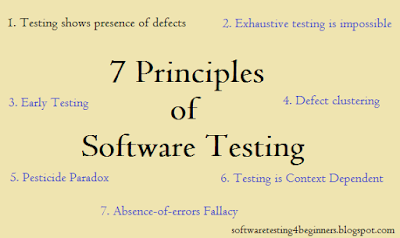
Being a Software Tester, we have to aware about Testing principles. Let's explain Seven testing principles below here:-
1. Testing shows presence of defects:- Testing never proves that there are no defects in the application. It only can show that defects are present in the application. Testing mitigates the probability of undiscovered defects existing in an application or in the software. Although, even if no defects are found in the software, it's not a that software is 100% correct.
2. Exhaustive testing is impossible:- Testing everything thoroughly (with all combinations of inputs & preconditions) isn't possible or feasible except trivial cases. We test an application on the bases of risks and priorities instead of exhaustive testing.
3. Early Testing:- Software testing activities should start at a very early stage of software development life cycle (SDLC) and should be focused on defined objectives.
4. Defect clustering:- A small numbers of units contain bunch of defects that are discovered during pre-release testing. or it shows the most operational failures.
5. Pesticide paradox:- If the same set of tests are repeated over and over again, ultimately the same set of test cases will no longer detect any new bugs. Therefore, to overcome this pesticide paradox, the test cases need to be regularly reviewed and revised.
6. Testing is context dependent:- Testing is performed differently in different contexts. For example:- critical or safety application is testing differently from an e-commerce site.
7. Absence-of-errors fallacy:- Detecting and fixing bugs or defects doesn't help if the system built doesn't fulfill the user's needs and expectations.
Thanks for reading my blog. Please leave comment below if you like this post.
Happy Testing..!!


















